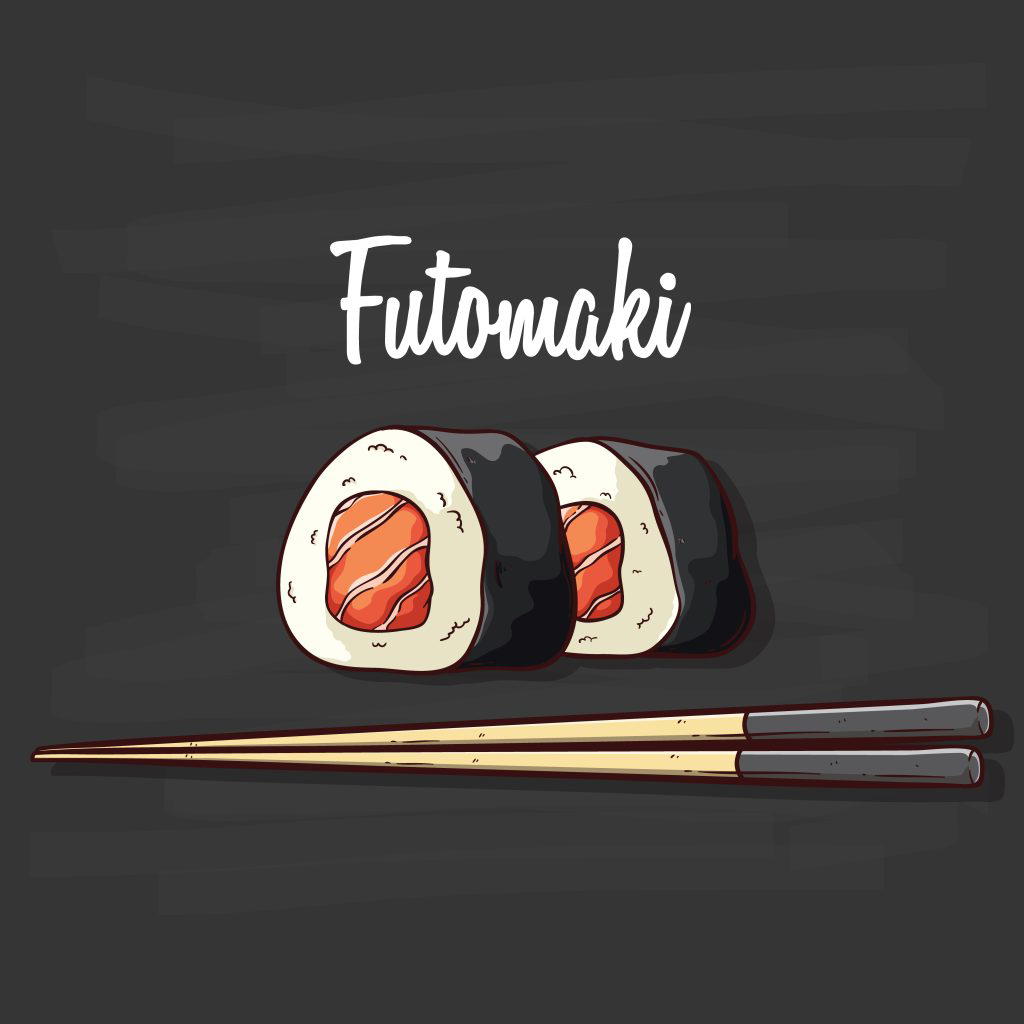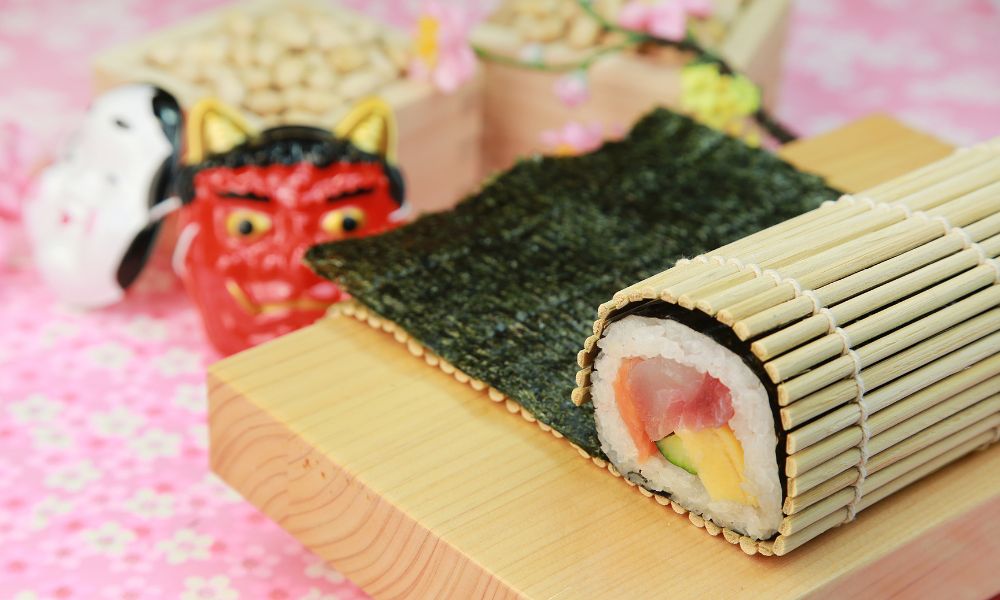Learn what futo maki is, what ingredients and filings are used in futo maki, and how to make this classic Japanese sushi roll the right way for the best taste.

When speaking about sushi, those of us who are not from Japan tend to think of California rolls or tempura rolls, or sushi made with smoked salmon or tuna. But did you know that there’s something from the sushi family that’s a bit different?
Introducing futomaki sushi – a thick sushi roll that is very popular in Japan. Futomaki definition literally means fat roll. These futomaki sushi rolls are typically made with nori (seaweed paper), sushi rice, and various fillings. The futomaki sushi roll is usually large in size and can be cut into six to eight pieces. It is often eaten during the Japanese New Year and on special occasions.
Futo maki: A Closer Look

Sushi in Japan generally refers to the traditional “nigiri sushi” type or classic sushi roll, which consists of raw fish on top of a rice pillow. However, when we use the term “sushi roll,” we often mean futomaki, a fat, rolled sushi with various colorful fillings.
In the Osaka region, the phrase “Maki Sushi” is frequently used. Sushi rolls are referred to as nori maki in the Tokyo area. Based on the size of the rolls, it is further split into Futomaki, Chumaki, and Hosomaki.
The size of futomaki sushi roll sets it apart from other varieties of sushi. Not only is it the size of a burrito but also the futomaki style sushi rolls have at least three or more items inside. Let’s take a quick look at the main traits of a futomaki roll.
- Thickness – Futomaki rolls are 5-6 centimeters or 2 to 2.5 inches thick in diameter
- Fillings – Futomaki fillings have various vegetables as their stuffing as well as cooked fish like freshwater eel (unagi) or saltwater eel (anago) and sakura denbu or dried cod flakes
- Ingredients – Futomaki ingredients consist of a mix of both dried and fresh ingredients that are commonly stored in a Japanese household
- Preparation – Futomaki is made by hand and can be made ahead of time
Futomaki, Norimaki, Chumaki, And Hosomaki
| Futomaki | One type of maki with vegetables, fish, meat, etc inside and thick and larger in size |
| Norimaki | Maki made with a nori or seaweed wrap outside |
| Chumaki | Maki that is smaller than futomaki but larger than hosomaki and contains 3 to 4 ingredients |
| Hosomaki | One type of maki with one ingredient – salmon or ahi tuna – and small in size |
What Is In Futomaki Roll?

The futomaki fillings may be vegetarian and include pieces of raw fish or even meat. It depends on the family traditions but some of the more common futomaki roll stuffing include cucumber, boiled spinach, shiitake mushrooms, and tamagoyaki or rolled omelet.
Some special ingredients like kanpyo or seasoned gourd strips deserve a mention. The material for kanpyo is dried calabash shavings. A variety of gourd is the calabash. The standard filling for futomaki (thick rolls) sushi rolls is kanpyo. Typically, soy sauce, sugar, and mirin are used to cook and flavor it.
Other components include koyadofu (freeze-dry tofu), shiso leaves, pickled ginger, carrots, salmon, tuna, kamaboko fish cakes (or imitation crab), and Mitsuba. With its fresh taste, the mitsuba is a Japanese herb that helps to balance the overall sushi futomaki. It’s readily available in Japanese grocery stores.
The number of such fillings can go up from three to five or even ten! The trick is not the number of futomaki roll ingredients but how well you can balance the taste and the texture without having an overpowering effect from any single one.
Another trick is to use a sharp knife so that the vibrant fillings in the futomaki should be seen in all their glory when it is cut.
Futomaki Recipe
In this post, I’m going to share a futomaki recipe with you – one that uses fish. The futomaki ingredients are divided into five parts – sushi rice, futomaki fillings, seasoned shiitake and kanpyo, wrapping the sushi rolls, and for garnish. Let’s find out how to make futomaki sushi rolls!
Maki Sushi With Vegetables And Unagi
Ingredients For Sushi Rice:
- 540 milliliter or 3 cups of rice cooker cups of short-grained Japanese rice or sushi rice
- 540 milliliter or 3 cups of water for soaking
- ⅓ cup unseasoned rice vinegar or any of the 6 things you can substitute for rice vinegar
- A 2-inch by 2-inch piece of kombu or dried kelp
- 3 tablespoons of sugar
- 1½ teaspoon Kosher salt or ½ teaspoon table salt
Note: If you are using bottled sushi vinegar, skip both the salt and sugar.
Ingredients For Seasoned Shiitake And Kanpyo:
- 1 cup of water for soaking
- 8 dried shiitake mushrooms
- 0.4 ounce of kanpyo or dried gourd strips
- 1 teaspoon Kosher salt or half the amount of table salt
- 1 tablespoon each of soy sauce, mirin, and sugar
Ingredients For Futomaki Fillings:
- Prepared seasoned shiitake and kanpyo as described above
- 1.4 ounces of sakura denbu (seasoned cod fish flakes)
- Tamagoyaki or Japanese rolled omelet
- 1 broiled fillet of freshwater eel or unagi
- 1 cucumber
- A handful of mitsuba or spinach
Ingredients For Wrapping Sushi Rolls:
- 4 sheets of nori
- ¼ cup of water for finger dipping
- 2 teaspoons unseasoned rice vinegar for finger dipping
Ingredients For Garnish (optional)
- Gari (pickled ginger)
Step-By-Step Directions
- Rinse the rice thoroughly, then drain off any excess water to make sushi rice. Place the rice and cool water with the kombu on top in a rice cooker and soak for 20-30 minutes before cooking as per the rice cooker’s instructions.
- To make the sushi vinegar, add salt, sugar, and unseasoned rice vinegar in a small saucepan and boil over medium heat until the sugar is dissolved.
- Spread the prepared sushi rice evenly on the sushi oke to help it cool more quickly. Over the rice, pour the hot sushi vinegar. Mix the ingredients gently with a rice paddle. By cooling the rice with a hair dryer, you can keep it from getting mushy.
- To prepare the seasoned shiitake and kanpyo, soak the dried shiitake mushrooms in water for 15 minutes.
- Bring a small pot of water to boil. Rinse the kanpyo, rub it with some salt, and rinse again. Drain the kanpyo and boil in the water for 3 minutes. Next, take them out and put them in an ice bath to stop the cooking process and squeeze off as much water as possible.
- Remove and discard the stem when the shiitake mushrooms are tender and soft. Pass the shiitake liquid through a fine sieve to remove tiny unwanted pieces. If this liquid is not a cup or 140 milliliters, add more water to make it so.
- Add the kanpyo, mushrooms, shiitake liquid, mirin, sugar, and soy sauce into a saucepan and bring to a boil. Check if the soy sauce has gone bad. When it starts boiling, lower the flame to medium and simmer for 20 to 30 minutes until the liquid has evaporated.
- Thinly slice the shiitake mushrooms and squeeze out excess liquid. Drain the kanpyo and cut it into 8-inch strips. You can make them ahead and store them in the fridge for two days.
- Make the tamagoyaki and cut it into thin and long strips. You can also make it ahead and refrigerate it.
- When you buy unagi, it is usually already cooked or grilled. Reheating in the oven is all that is required. For three minutes, preheat your oven to 550°F (290°C) to broil. Put aluminum foil on the baking sheet to line it. Place the unagi on top of the aluminum foil after applying oil. Place the baking sheet on the center shelf of the oven, then broil for 5 to 7 minutes without flipping. Cut into four long strips.
- If you’re using spinach or mitsuba, tie the stems together so they remain in place when you’re boiling them. Into a pot of boiling water, add a teaspoon of salt to blanch the spinach or mitsuba without overcooking them. Then put it in an ice bath and squeeze out excess water.
- Prepare the cucumber by removing the ends and cutting it into length-wise quarters and removing the seeds.
- Take the sakura denbu out from the packaging and set it aside in a bowl.
- Prepare the finger dipping liquid or Tezu by combining ¼ cup of water and 2 teaspoons of rice vinegar.
- Now comes the part where you will learn how to roll futomaki sushi roll. Put the bamboo sushi mat on a countertop or flat surface. Put a sheet of nori with the shiny side down on the sushi mat. Make four equal divisions of the sushi rice. After wetting your fingers with the Tezu, put a quarter of the sushi rice on the nori sheet and lay evenly on the sushi mat using your fingers.
- Put a gap of half an inch toward the top part of the nori sheet that is farthest away from you. This is important so that you don’t fill it to the edge with sushi rice which may come out when you roll the futomaki.
- Put the cucumber at the bottom of the nori sheet and place easy-to-hold ingredients toward the front part of the nori like the sakura denbu and mushrooms. Start rolling the nori sheet over the filling tightly and firmly with a bamboo mat from the bottom end of the sushi rice up to the top end of the sushi rice. When rolling, hold the ingredients between your fingertips.
- When rolling a bamboo mat, grip the top with one hand and the rolled bamboo mat with the other. Pull them together to tighten the roll. Lift the bamboo mat, then go on rolling. Stretch the bamboo mat tightly over the roll. Make four rolls.
- With a sharp knife, cut each crispy futomaki into half and slice each half into three pieces and garnish with pickled ginger.
Pro Tip: Wet your knife between making each cut to ensure the futomaki cuts smoothly.
For a futomaki vegetarian option, simply skip the eel or any kind of cooked seafood or meat.
If you want to make an easy futomaki California roll aka maki sushi, refer to this video for its recipe.
If you love making Japanese cuisine as I do, you should learn how to make the best kani sushi at home.
FAQs
What Is Futomaki Roll Made Of?
Futomaki roll is made of sushi rice, nori seaweed sheet, vegetables, and fish or meat.
How To Eat Futomaki?
As the futomaki is larger in size than the usual sushi rolls, you need a plate or tray to catch the ingredients when you take a bite. It’s not a bite-size sushi so you will need to take a couple of bites off the futomaki. You will also need a large sauce tray to dip your futomaki into sauce.






